Complementary Agriculture (AgriCom): A Low-Cost Strategy to Improve Profitability and Sustainability in Rural Communities in Semi-Arid Regions
Abstract
1. Introduction
2. Materials and Methods
2.1. Geographical Area of Intervention
2.2. Research Phases
2.3. Plant Yield Variables
2.4. Equivalent Land Use (ELU)
2.5. Collection, Uses and Geographical Origins
2.6. Production Yields and Costs
2.7. Minimum Infrastructure
2.8. Statistical Analysis
3. Results
3.1. First Phase: Survival After Sowing and Emission of the Second and Third Levels of Cladodes
3.2. Yields and ELU
3.3. General Costs and Profitability Indices
3.4. Structuring of the Rainwater Harvesting System, Emergency Irrigation System
3.5. Conservation of Genotypes Collected
4. Discussion
Limitations and Future Perspectives of the Research
5. Conclusions
Author Contributions
Funding
Institutional Review Board Statement
Informed Consent Statement
Data Availability Statement
Acknowledgments
Conflicts of Interest
Abbreviations
| AGRICOM | Complementary Agriculture |
| ELU | Equivalent Land Use |
| RTR | Relative Total Yield |
| GRFA | Genetic Resources for Food and Agriculture |
| NPV | Net Present Value |
| IRR | Internal Rate of Return |
References
- García-Sandoval, J.R.; Aldape-Ballesteros, L.A.; Esquivel, F.A. Perspectivas del desarrollo social y rural en Mexico. Rev. Cienc. Soc. (Ve) 2020, 26, 45–55. Available online: https://www.redalyc.org/articulo.oa?id=28063519011 (accessed on 20 February 2025).
- Ramírez Juárez, J. Seguridad alimentaria y la agricultura familiar en Mexico. Rev. Mex. Cienc. Agrícolas 2022, 13, 553–565. [Google Scholar] [CrossRef]
- Merino Pérez, L. Crisis Ambiental en Mexico: Ruta Para el Cambio; Secretaría de Desarrollo Institucional: Mexico City, Mexico, 2019; pp. 1–282. [Google Scholar]
- CDB. Convenio sobre la diversidad biológica. In Proceedings of the Programa de Las Nacionaes Unidas Para El Medio Ambiente, Rio de Janeiro, Brazil, 3–14 June 1992. [Google Scholar]
- Sánchez-Galán, E.A. Pobreza rural y agricultura familiar: Reflexiones en el contexto de América Latina. Rev. Espec. Cienc. Agropecu. 2021, 1, 27–35. [Google Scholar]
- Scott, J.S.; Gutiérrez, A.G.; Chávez, C.C. Medición Multidimensional de la Pobreza Rural en Mexico: Acceso Efectivo y Nuevas Dimensiones, 265th ed.; Instituto de Estudios Peruanos: Lima, Peru, 2019; Volume 39, Available online: https://repositorio.iep.org.pe/server/api/core/bitstreams/a876d7f6-4246-4edc-ad1d-bf4e16cf260f/content (accessed on 16 April 2025).
- Lorenzen, M. Nueva ruralidad y migración en la Mixteca Alta, Mexico. Perfiles Latinoam. 2021, 29, 1–29. [Google Scholar] [CrossRef]
- Yúnez Naude, A.; González Andrade, S. Efectos multiplicadores de las actividades productivas en el ingreso y pobreza rural en Mexico. El Trimest. Económico 2008, 75, 349–377. Available online: https://www.scielo.org.mx/pdf/ete/v75n298/2448-718X-ete-75-298-349.pdf (accessed on 13 April 2025). [CrossRef]
- Pedro-Valencia, G.; López-García, A.; Rodiles-Hernández, S.; Camacho-Vera, J. Incidencia de las políticas públicas en la reconfiguración del sector agrario en Mexico. SUMMA Rev. Discip. Cienc. Económicas Y Soc. 2022, 4, 1–20. [Google Scholar] [CrossRef]
- FAO. The State of the World’s Biodiversity for Food and Agriculture; FAO Commission on Genetic Resources for Food and Agriculture Assessments: Rome, Italy, 2019. [Google Scholar] [CrossRef]
- Hernández Sánchez, M.I.; Travieso Bello, A.C. Medidas de adaptación al cambio climático en Organizaciones cafetaleras de la zona centro de Veracruz, Mexico. Trop. Subtrop. Agroecosyst. 2021, 24, 23. [Google Scholar] [CrossRef]
- Nicholls, C.I.; Altieri, M.A. Bases agroecológicas para la adaptación de la agricultura al cambio climático. UNED Res. J. 2019, 11, 55–61. [Google Scholar] [CrossRef]
- Lorenzen, M.; Orozco-Ramírez, Q.; Ramírez-Santiago, R.; Garza, G.G. Migration, socioeconomic transformation, and land-use change in Mexico’s Mixteca Alta: Lessons for forest transition theory. Land Use Policy 2020, 95, 104580. [Google Scholar] [CrossRef]
- Gliessman, S.R. Agroecología: Procesos ecológicos en agricultura sostenible. In Diversidad y Estabilidad del Agroecosistema; CATIE: Turrialba, Costa Rica, 2002. [Google Scholar]
- Gutiérrez Alzate, F. Práctica Tradicional de Agricultura: Los Policultivos como Estrategia de Sustento Económico y Conservación de los Recursos Naturales In Situ en el Corregimiento de Santa Cecilia–Pueblo Rico. Bachelor’s Thesis, Universidad Católica de Pereira, Pereira, Colombia, 2020. Available online: https://repositorio.ucp.edu.co/entities/publication/92d4bff8-54ca-4f31-9ea7-c8bce4662381 (accessed on 24 April 2025).
- Calderón-Ruiz, A.; Martínez-Camacho, A.P. Asociación de cultivos: Cacahuate (Arachis hypogaea L.) como base. Debates Sobre Innovación 2024, 8, 3. Available online: https://revistadebates.xoc.uam.mx/index.php/debinnovacion/article/view/156/147 (accessed on 17 February 2025).
- Organización de las Naciones Unidas para la Alimentación y la Agricultura [FAO]. Agricultura Sostenible y Biodiversidad: Un Vínculo Indisociable. 2018. Available online: http://www.fao.org/3/i6602s/i6602s.pdf (accessed on 18 February 2025).
- Tamayo Ortiz, C.V.; Alegre Orihuela, J.C. Asociación de cultivos, alternativa para el desarrollo de una agricultura sustentable. Siembra 2022, 9, e3287. [Google Scholar] [CrossRef]
- Nunez, L.; Lucatti, L.; Pietrarelli, L. Evaluación del cultivo agroecológico de maíz, poroto y zapallito en policultivo. Nexo Agropecu. 2021, 9, 96–104. Available online: https://revistas.unc.edu.ar/index.php/nexoagro/article/view/33007 (accessed on 21 March 2025).
- Tobón-Salamanca, J.P. La ley antimonocultivo: Un compromiso con los suelos, el ambiente y la sociedad. Ainkaa Rev. Estud. Cienc. Política 2022, 6, 20–46. [Google Scholar]
- Yzarra-Aguilar, A.; Hinojosa-Yzarra, L.A.; Quispe-Villanueva, M.M.; Muñoz-Ávila, V.; Cruz-Quispe, B. Importancia de la asociación de leguminosas con cereales: Caso de soya y maíz. Sci. Res. J. CIDI 2023, 3, 42–57. [Google Scholar]
- Gallardo-Milanés, O.A. Agricultura Familiar Y La Adaptación Al Cambio Climático En Coaprocor-Paraná, Brasil. Agroecol. Métodos E Técnicas Para Uma Agric. Sustentável 2021, 1, 379–399. [Google Scholar] [CrossRef]
- Hernández, A.P. Reflexión sobre la pobreza rural en la región planicie huasteca del Estado de San Luis Potosí, Mexico. CIBA Rev. Iberoam. Las Cienc. Biológicas Y Agropecu. 2016, 5, 68–88. Available online: https://www.ciba.org.mx/index.php/CIBA/article/view/51 (accessed on 28 April 2025).
- Díaz-Sánchez, F.; Cadena-Iñiguez, J.; Gómez-González, A.; Ruiz-Vera, V.M.; Morales Flores, F.J.; Bustamante-Lara, T.I. Modelo de producción y conservación de germoplasma (AgriCom) en una comunidad rural del semidesierto mexicano. Agro-Divulgación 2022, 2, 13–18. [Google Scholar] [CrossRef]
- Díaz-Sánchez, F.; Cadena-Iñiguez, J.; Gómez-González, A.; Ruiz-Vera, V.M.; Morales-Flores, F.J. Soluciones tecnológicas de bajo costo con recursos locales en un modelo de agricultura complementaria. In Proceedings of the XXVII International Congress on Project Engineering Management (CIDIP 2023), San Sebastián, Spain, 12–13 July 2023; AEIPRO: Valencia, Spain, 2023. [Google Scholar] [CrossRef]
- Santiago-Zongua, D.M.; Lizárraga-Mendiola, L. Cosecha de lluvia para reducir la escasez hídrica en una zona rural de Puebla. Pädi Boletín Científico Cienc. Básicas E Ing. Del ICBI 2022, 10, 161–168. [Google Scholar] [CrossRef]
- Aceves-Navarro, E.; Reyes-Montero, J.A.; Vera-Espinoza, J. Abastecimiento con agua de lluvia a comunidades rurales del Estado de Campeche, Mexico. Agro-Divulgación 2021, 1, 5–7. [Google Scholar] [CrossRef]
- Acevedo-Osorio, A.; Ortiz Przychodzka, S.; Ortiz Pinilla, J.E. Aportes De La Agrobiodiversidad a La Sustentabilidad De La Agricultura Familiar En Colombia. Trop. Subtrop. Agroecosyst. 2020, 23, 2. [Google Scholar] [CrossRef]
- FAO. Segundo Plan de Acción Mundial para los Recursos Fitogenéticos para la Alimentación y la Agricultura. In Informes De Organizaciones Internacionales Sobre sus Políticas, Programas Y Actividades En Relación con la Diversidad Biológica Agrícola; FAO: Rome, Italy, 2012. [Google Scholar]
- SADER. Programa de Trabajo Multianual del Comité Sectorial de Recursos Genéticos para la Alimentación y la Agricultura 2022–2024. Diversidad Genética para la Producción Sostenible, la Adaptación al Cambio Climático y el Bienestar; SADER: Mexico City, Mexico, 2022; pp. 1–135. [Google Scholar]
- FAO. Bosques y biodiversidad agrícola para la seguridad alimentaria en América Central. In Biodiversidad Agrícola; FAO: Rome, Italy, 2007. [Google Scholar]
- DOF. Acuerdo por el que se Crea el Comité Sectorial de Recursos Genéticos para la Alimentación y la Agricultura; Diario Oficial de La Federación: Mexico City, Mexico, 2020; pp. 3–5.
- Zimmerer, K.S.; de Haan, S.; Jones, A.D.; Creed-Kanashiro, H.; Tello, M.; Carrasco, M.; Meza, K.; Plasencia Amaya, F.; Cruz-Garcia, G.S.; Tubbeh, R.; et al. The biodiversity of food and agriculture (Agrobiodiversity) in the anthropocene: Research advances and conceptual framework. Anthropocene 2019, 25, 100192. [Google Scholar] [CrossRef]
- INEGI. Panorama sociodemográfico de San Luis Potosí. In Censo de Población y Vivienda 2020; INEGI: Aguascalientes, Mexico, 2020; Available online: https://www.inegi.org.mx/contenidos/productos/prod_serv/contenidos/espanol/bvinegi/productos/nueva_estruc/702825197971.pdf (accessed on 30 April 2025).
- Cadena-Iñiguez, J.; Ruiz-Posadas Ldel, M.; Trejo-Téllez, B.I.; Morales-Flores, F.J.; Talavera-Magaña, D. Red doméstica de producción de nopal (Nopalea sp.) para exportación. Agro Product. 2019, 12, 75–77. [Google Scholar] [CrossRef]
- Mead, R.; Willey, R.W. The concept of a “land equivalent ratio” and advantages in yields from intercropping. Exp. Agric. 1980, 16, 217–228. [Google Scholar] [CrossRef]
- Domínguez García, M.V. (Ed.) Principios Activos de las Plantas Usadas en la Medicina Tradicional Mexicana; Universidad Autónoma del Estado de Mexico: Toluca, Mexico, 2023; ISBN 978-607-633-582-6. [Google Scholar]
- SNICS. El Sistema de Información de Bancos de Germoplasma Mexicano (BanGERMEX); SNICS: Tlalnepantla, Mexico, 2018. Available online: https://www.gob.mx/snics/articulos/que-es-el-bangermex?idiom=es (accessed on 3 April 2024).
- Servicio Nacional de Inspección y Certificación de Semillas (SNICS). Programa Nacional de Semillas 2020–2024; SNICS: Tlalnepantla, Mexico, 2020. Available online: https://www.dof.gob.mx/nota_detalle_popup.php?codigo=5608920 (accessed on 3 April 2024).
- Sánchez Moreno, D.E. Análisis de la Agricultura Regenerativa Como Práctica Sostenible para la Gestión y Uso del Suelo en Colombia. Agricultura Regenerativa Como Práctica Sostenible. Bachelor’s Thesis, Especialización en Gestión Integral Ambiental, Facultad de Ingeniería, Universidad Militar Nueva Granada, Bogotá, Colombia, 2023. [Google Scholar]
- Vázquez, J.; Álvarez-Vera, M.; Iglesias-Abad, S.; Castillo, J. La incorporación de enmiendas orgánicas en forma de compost y vermicompost reduce los efectos negativos del monocultivo en suelos. Sci. Agropecu. 2020, 11, 105–112. [Google Scholar] [CrossRef]
- Carranza-Cárdenas, C.C. Eficiencia Agronómica de la Asociación de Cultivo Maíz (Zea mays) vs Leguminosas Fréjol Cuarentón (Phaseolus vulgaris L.)-Maní (Arachis hypogaea) y su Efecto en el Rendimiento. Bachelor’s Thesis, Universidad Técnica Estatal de Quevedo, Quevedo, Ecuador, 2021. Available online: https://repositorio.uteq.edu.ec/items/dce875bb-b57e-4623-93d1-eb899a1697ea (accessed on 1 October 2025).
- Arteaga-Rodríguez, O.; Espinosa Aguilera, W.; Bernal Carraza, Y.; Hernández-Rodríguez, C. Implantación de algunas prácticas del manejo sostenible de tierras en una finca agropecuaria en Cienfuegos, Cuba. Rev. Científica Agroecosistemas 2020, 8, 55–60. Available online: https://doaj.org/article/f309f0e4392947d8b39748495fcbf428 (accessed on 30 April 2025).
- Gómez-Betancur, L.M.; Márquez-Girón, S.M.; Restrepo-Betancur, L.F. La milpa como alternativa de conversión agroecológica de sistemas agrícolas convencionales de frijol (Phaseolus vulgaris), en el municipio El Carmen de Viboral, Colombia. Idesia 2018, 36, 123–131. [Google Scholar] [CrossRef]
- Vásquez González, A.Y.; Chávez Mejía, C.; Herrera Tapia, F.; Carreño Meléndez, F. Milpa y seguridad alimentaria: El caso de San Pedro El Alto, Mexico. Rev. Cienc. Soc. 2018, 24, 24–36. [Google Scholar] [CrossRef]
- Ochoa Lozano, J.B. Farmer Crop Variety Mixtures to Cope with Disease Epidemics in the Common Bean Cropping System of the Ecuadorian Highlands. Ph.D. Thesis, Università degli Studi di Roma “La Sapienza”, Rome, Italy, 2018; pp. 1–23. Available online: https://hdl.handle.net/11573/1077355 (accessed on 5 May 2025).
- Magra, G.C.; Saperdi, A.J.; Ferreras, L.A. Diagnosticar las reservas de agua útil: Una herramienta para la toma de decisiones y potenciar la rentabilidad económica del cultivo de trigo. Rev. Am. Empreendedorismo E Inovação Am. J. Entrep. Innov. 2021, 3, 7–18. [Google Scholar] [CrossRef]
- Jorge, A.O.S.; Costa, A.S.G.; Oliveira, M.B.P.P. Adapting to climate change with Opuntia. Plants 2023, 12, 2907. [Google Scholar] [CrossRef]
- Licerán Fuentes, D. Tolerancia de Opuntia spp. a Diferentes Tipos de Estreses Abióticos Relacionados con el Cambio Climático. Bachelor’s Thesis, Universidad Miguel Hernández de Elche, Elche, Spain, 2021. Available online: http://hdl.handle.net/11000/8720 (accessed on 5 May 2025).
- González Alfredo, N.; Rivera Martínez, J.G.; Vela Correa, G.; Silva Torres, B.; Puebla Torres, H.; Sánchez Martínez, M.; Reséndiz de la Rosa, G. Evaluación del contenido de carbono orgánico en suelos del cultivo intensivo de nopal (Opuntia ficus-indica L.) en la delegación de Milpa Alta, Mexico D.F. In Memorias del V Congreso Latinoamericano de Agroecología; Facultad de Ciencias Agrarias y Forestales (UNLP): La Plata, Argentina, 2015; ISBN 978-950-34-1265-7. Available online: https://sedici.unlp.edu.ar/bitstream/handle/10915/52510/Documento_completo.pdf?sequence=1 (accessed on 6 April 2025).
- Batáry, P.; Gallé, R.; Korányi, D.; Lakatos, T.; Deák, B.; Gallé-Szpisjak, N.; Kabai, M.; Koszta, C.; Kotowska, D.; Marja, R.; et al. Biodiversity and human well-being trade-offs and synergies in villages. Nat. Sustain. 2025, 8, 894–904. [Google Scholar] [CrossRef]
- Guo, B.; Jin, G. Heterogeneity of urban–rural responses to multigoal policy from an efficiency perspective: An empirical study in China. Habitat Int. 2025, 158, 103341. [Google Scholar] [CrossRef]
- Córdova-Quispe, D.M. Uso Equivalente de la Tierra y Características Biométricas del Cultivo Asociado de Lechuga (Lactuca sativa L.) y Cebolla (Allium cepa L.) Bajo Riego por Goteo. Bachelor’s Thesis, Repositorio Institucional UN, Universidad Nacional de Huancavelica, Huancavelica, Perú, 2021. Available online: https://repositorio.unh.edu.pe/items/c71219d3-c9b9-4a42-af76-f9aef0332df6 (accessed on 12 May 2025).
- Mola Fines, B.; Bonet Pérez, C.; Rodríguez Correa, D.; Guerrero Posada, P.; Avilés Martínez, G.; Martínez Der, C. Tecnologías para el uso eficiente de los recursos hídricos en fincas ganaderas. Rev. Ing. Agrícola 2021, 11, e09. Available online: https://www.redalyc.org/journal/5862/586267422009/html/ (accessed on 12 May 2025).
- Gordillo-Bartolo, F.I. Design of the Optimal Tank Size for a Rainwater Harvesting System at the University of Santander, Bucaramanga, Colombia. Bachelor’s Thesis, Faculty of Engineering, Universidad Autónoma del Estado de Mexico, Toluca, Mexico, 2022. Available online: https://ri.uaemex.mx/handle/20.500.11799/137445 (accessed on 14 May 2025).
- Román-Montes de Oca, E.; Licea-Resendiz, J.E.; Romero-Torres, F. Diversificación de ingresos de los productores como estrategias de desarrollo rural. Entramado 2020, 16, 126–148. [Google Scholar] [CrossRef]
- Lluch-Cota, S.E.; Velázquez Zapata, J.A.; Nieto Delgado, C. Agricultura, agua y cambio climático en zonas áridas de Mexico. Recur. Nat. Y Soc. 2022, 8, 35–48. [Google Scholar] [CrossRef]
- COP25. Conferencia de las Naciones Unidas sobre el Cambio Climático de 2019. 2019. Available online: https://es.wikipedia.org/wiki/Conferencia_de_las_Naciones_Unidas_sobre_el_Cambio_Clim%C3%A1tico_de_2019 (accessed on 10 June 2025).
- PLACA. Plataforma de Acción Climática en Agricultura de Latinoamérica y el Caribe. 2025. Available online: https://accionclimaticaplaca.org/es/sobre-placa/ (accessed on 22 June 2025).
- Casas, A.; Caballero, J.; Mapes, C.; Zárate, S. Manejo de la vegetación, domesticación de plantas y origen de la agricultura en Mesoamérica. Bot. Sci. 1997, 61, 31–47. [Google Scholar] [CrossRef]

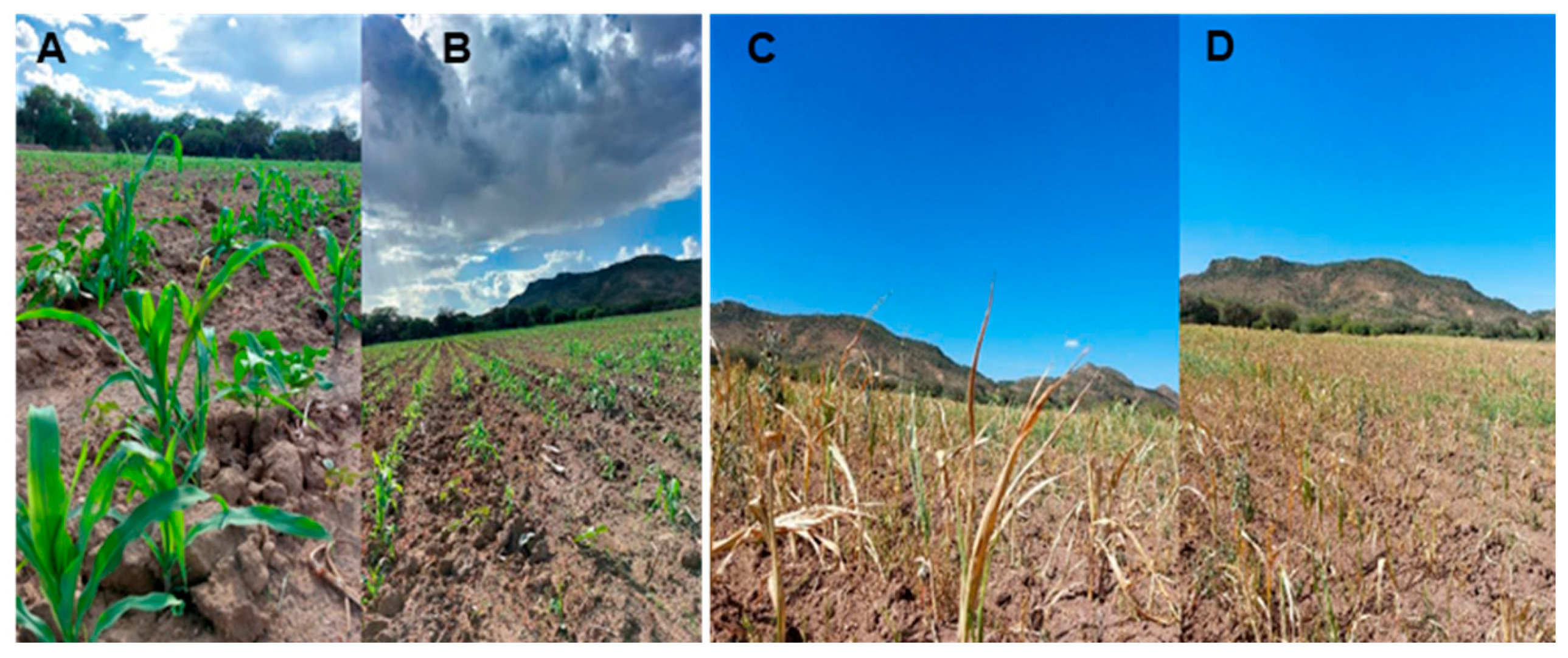
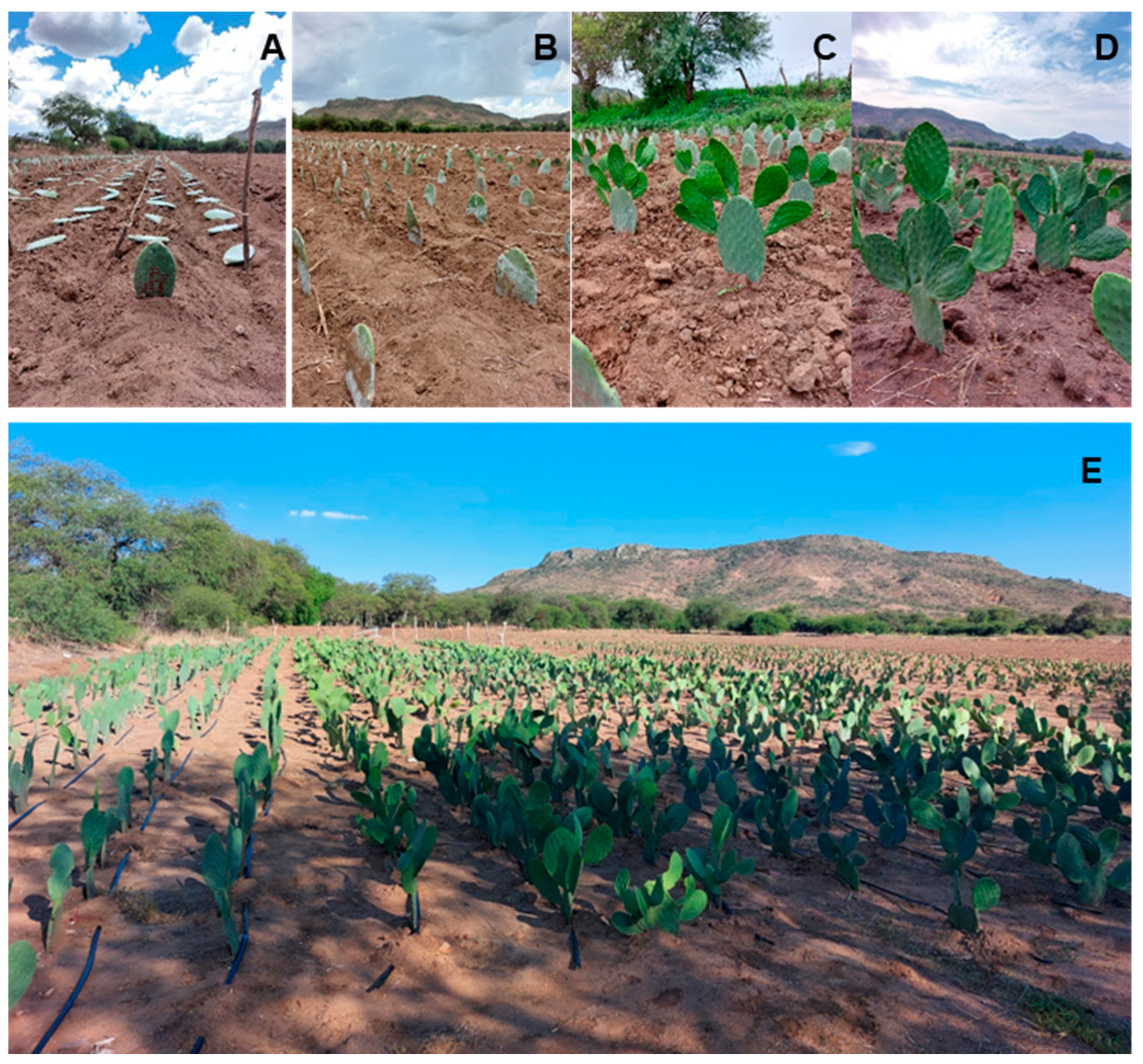
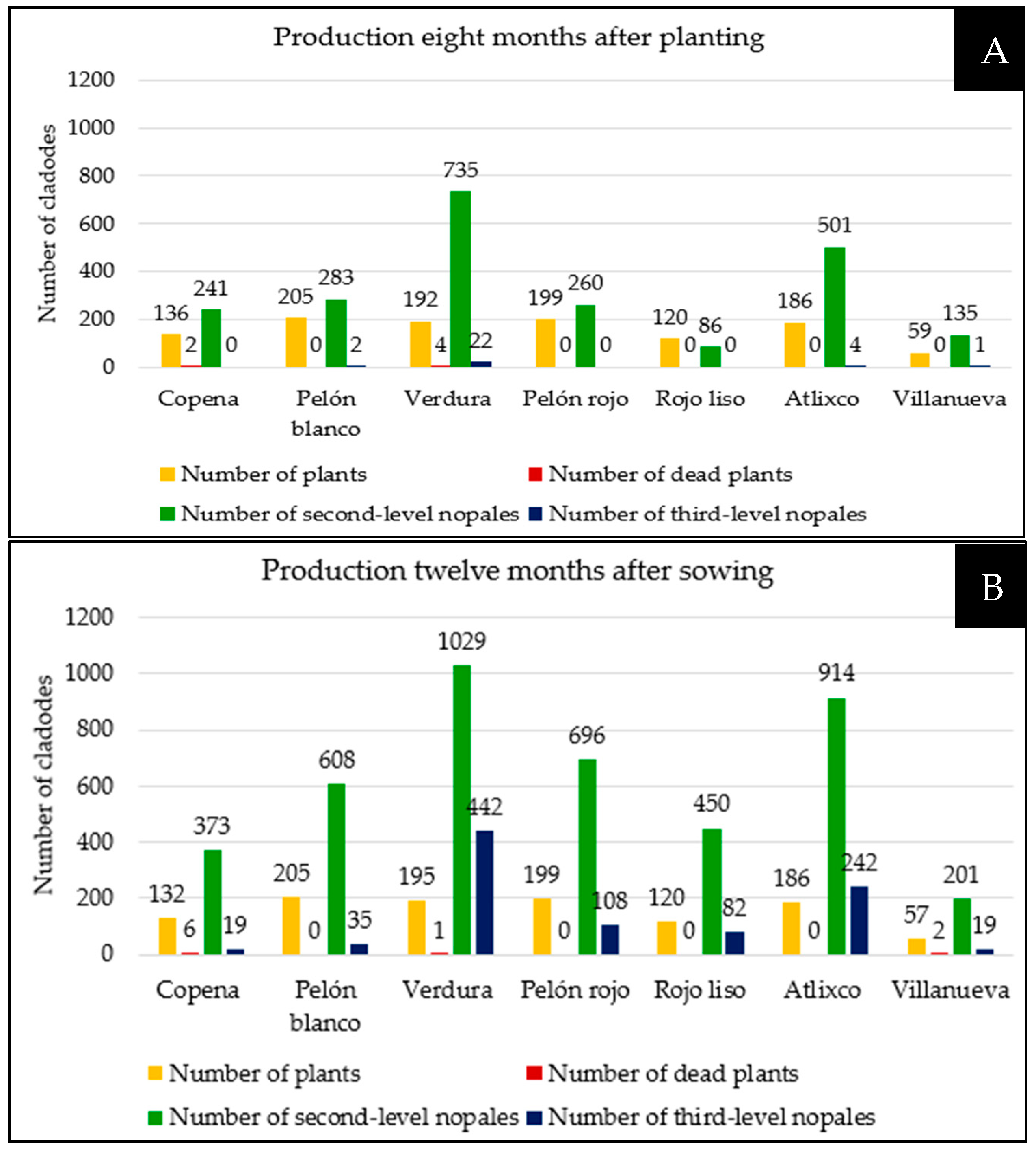
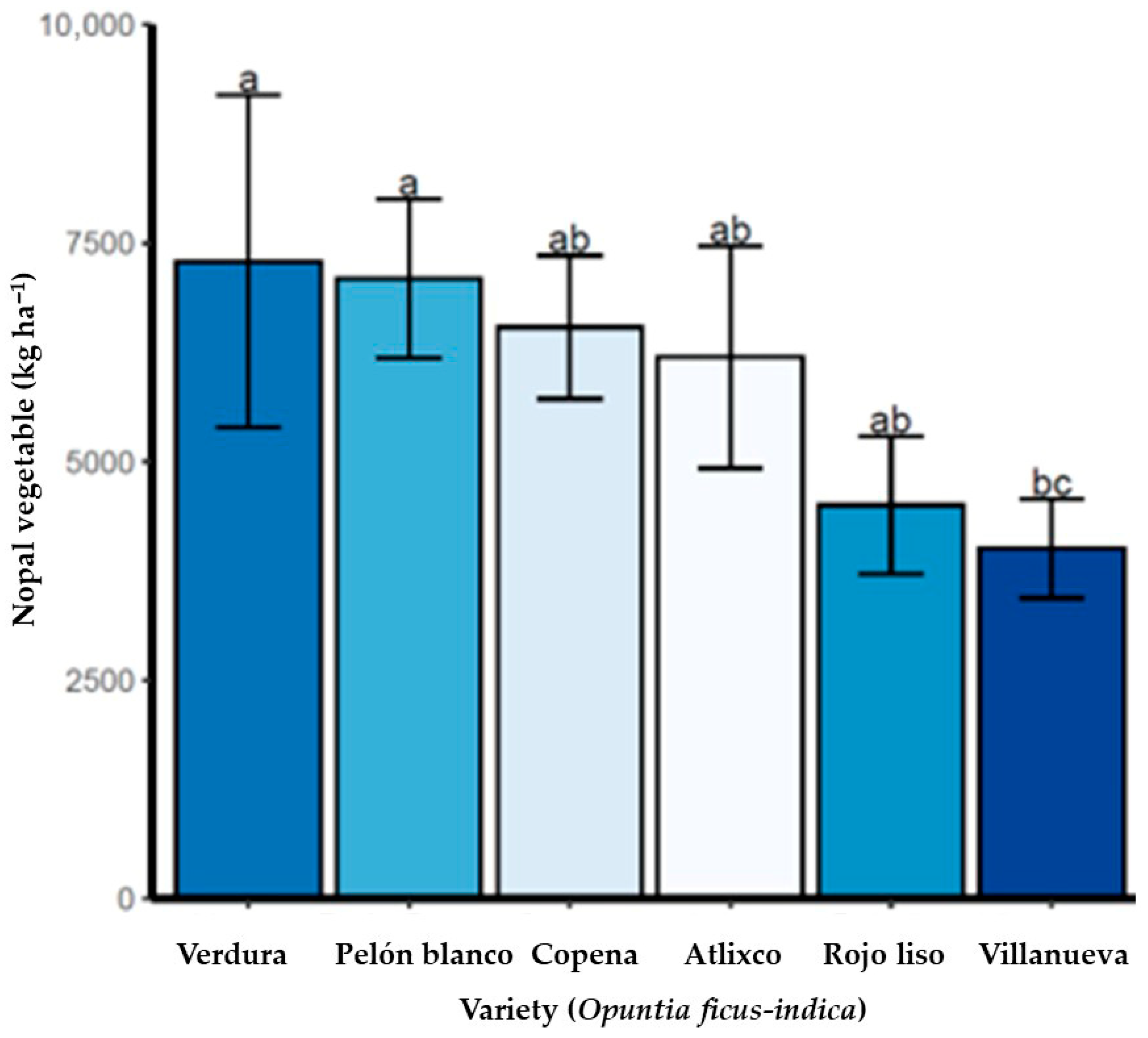

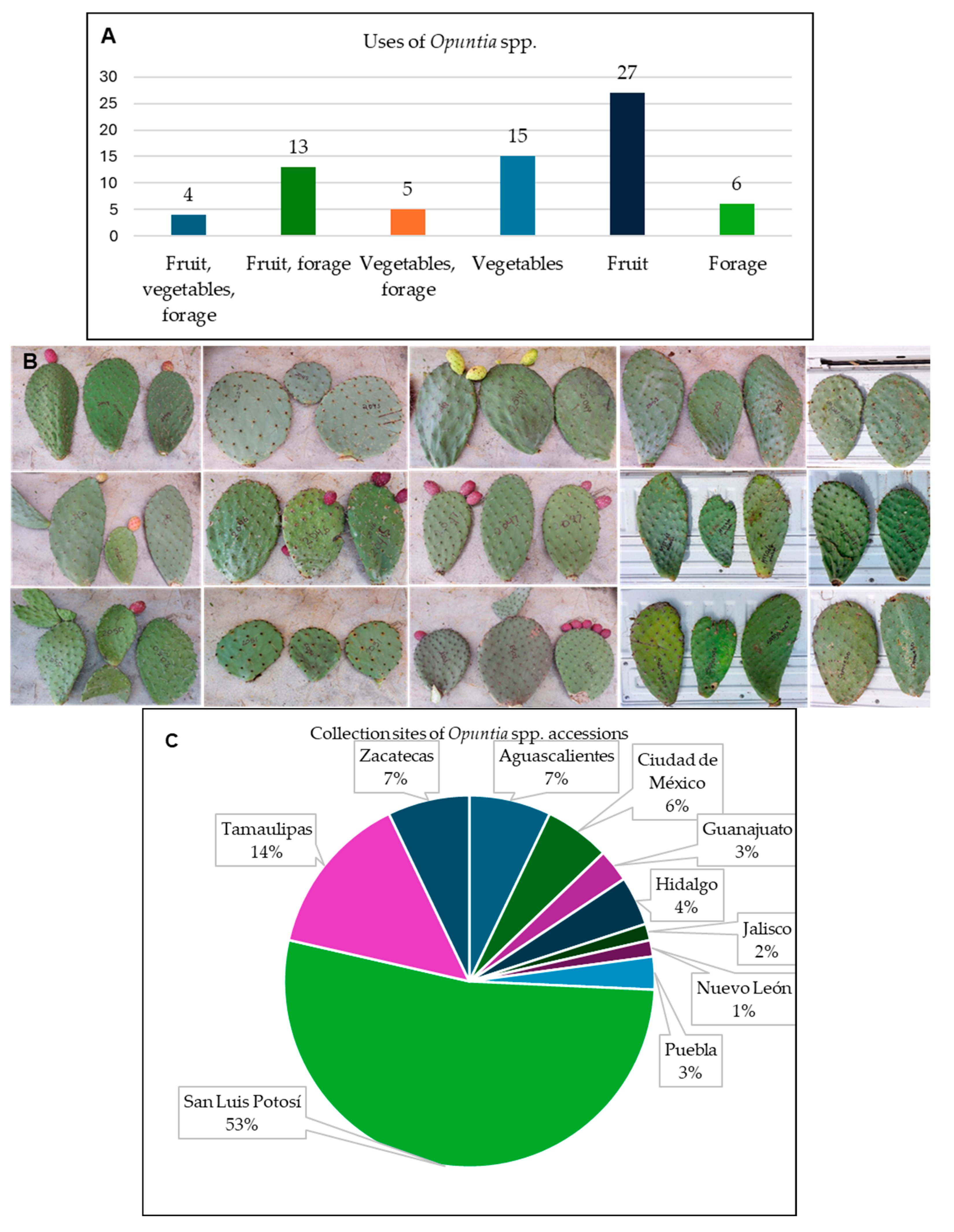
| Species | Variety | Use | Density (Plants ha−1) |
|---|---|---|---|
| Opuntia ficus-indica Mill. | Copena | Vegetable | 20,952 |
| Opuntia ficus-indica Mill. | Pelón blanco | Forage | 20,952 |
| Opuntia ficus-indica Mill. | Verdura | Vegetable | 20,952 |
| Opuntia ficus-indica Mill. | Pelón rojo | Forage | 20,952 |
| Opuntia ficus-indica Mill. | Rojo liso | Vegetable | 20,952 |
| Opuntia ficus-indica Mill. | Atlixco | Vegetable | 20,952 |
| Opuntia ficus-indica Mill. | Villanueva | Vegetable | 20,952 |
| Zea mays L. | Criollo local | Grain | 20,000 |
| Variety (Opuntia ficus-indica | Second Level Emission (t ha−1) | Third Level Emission (t ha−1) | Emission Ratio Between Second and Third Level (%) |
|---|---|---|---|
| Verdura | 10.83 | 4.653 | 42.96 |
| Atlixco | 10.38 | 2.750 | 26.49 |
| Rojo liso | 8.33 | 1.519 | 18.24 |
| Pelón rojo | 7.40 | 1.149 | 15.53 |
| Villanueva | 6.70 | 0.633 | 9.45 |
| Pelón Blanco | 6.40 | 0.368 | 5.75 |
| Copena | 5.921 | 0.302 | 5.10 |
| Variety | Yield (kg ha−1) | Income $ ha−1 ($10.00 kg) | Yield (kg ha−1) | Income $ ha−1 ($10.00 kg) | Yield (kg ha−1) | Income $ ha−1 ($10.00 kg) | ELU (Nopal Variety Versus Corn) |
|---|---|---|---|---|---|---|---|
| R1 | R2 | R3 | |||||
| Verdura | 5276.92 | 52,769.23 | 7543.59 | 75,435.90 | 9052.31 | 90,523.08 | >1.0 |
| Atlixco | 6400.00 | 64,000.00 | 6768.42 | 67,684.21 | 8122.11 | 81,221.05 | >1.0 |
| Rojo liso | 5920.63 | 59,206.35 | 6222.22 | 62,222.22 | 7466.67 | 74,666.67 | >1.0 |
| Pelón rojo | 4913.98 | 49,139.78 | 6215.05 | 62,150.54 | 7458.06 | 74,580.65 | >1.0 |
| Villanueva | 3750.00 | 37,500.00 | 4433.33 | 44,333.33 | 5320.00 | 53,200.00 | >1.0 |
| Pelón Blanco | 3497.49 | 34,974.87 | 4040.20 | 40,402.01 | 4848.24 | 48,482.41 | >1.0 |
| Copena | 3526.32 | 35,263.16 | 3859.65 | 38,596.49 | 4631.58 | 46,315.79 | >1.0 |
| Corn | 0.00 | 0.00 | 0.00 | 0.00 |
| Variety (Opuntia ficus-indica) | Net Present Value (NPV) | Internal Rate of Return (IRR %) | Benefit/Cost Ratio (B/CR) |
|---|---|---|---|
| Verdura | 231,077.73 | 67 | 7.97 |
| Atlixco | 143,831.02 | 70 | 6.35 |
| Rojo liso | 139,288.51 | 51 | 6.82 |
| Pelón rojo | 99,715.71 | 48 | 6.28 |
| Villanueva | 88,646.13 | 42 | 5.67 |
| Pelón Blanco | 51,580.62 | 26 | 5.40 |
| Copena | 38,630.41 | 21 | 4.93 |
Disclaimer/Publisher’s Note: The statements, opinions and data contained in all publications are solely those of the individual author(s) and contributor(s) and not of MDPI and/or the editor(s). MDPI and/or the editor(s) disclaim responsibility for any injury to people or property resulting from any ideas, methods, instructions or products referred to in the content. |
© 2025 by the authors. Licensee MDPI, Basel, Switzerland. This article is an open access article distributed under the terms and conditions of the Creative Commons Attribution (CC BY) license (https://creativecommons.org/licenses/by/4.0/).
Share and Cite
Díaz-Sánchez, F.; Cadena-Iñiguez, J.; Ruiz-Vera, V.M.; Silos-Espino, H.; Trejo-Téllez, B.I.; García-Reyes, A.; Yagüe-Blanco, J.L.; Sánchez-Escudero, J. Complementary Agriculture (AgriCom): A Low-Cost Strategy to Improve Profitability and Sustainability in Rural Communities in Semi-Arid Regions. Sustainability 2025, 17, 9481. https://doi.org/10.3390/su17219481
Díaz-Sánchez F, Cadena-Iñiguez J, Ruiz-Vera VM, Silos-Espino H, Trejo-Téllez BI, García-Reyes A, Yagüe-Blanco JL, Sánchez-Escudero J. Complementary Agriculture (AgriCom): A Low-Cost Strategy to Improve Profitability and Sustainability in Rural Communities in Semi-Arid Regions. Sustainability. 2025; 17(21):9481. https://doi.org/10.3390/su17219481
Chicago/Turabian StyleDíaz-Sánchez, Fernanda, Jorge Cadena-Iñiguez, Víctor Manuel Ruiz-Vera, Héctor Silos-Espino, Brenda I. Trejo-Téllez, Alberto García-Reyes, José Luis Yagüe-Blanco, and Julio Sánchez-Escudero. 2025. "Complementary Agriculture (AgriCom): A Low-Cost Strategy to Improve Profitability and Sustainability in Rural Communities in Semi-Arid Regions" Sustainability 17, no. 21: 9481. https://doi.org/10.3390/su17219481
APA StyleDíaz-Sánchez, F., Cadena-Iñiguez, J., Ruiz-Vera, V. M., Silos-Espino, H., Trejo-Téllez, B. I., García-Reyes, A., Yagüe-Blanco, J. L., & Sánchez-Escudero, J. (2025). Complementary Agriculture (AgriCom): A Low-Cost Strategy to Improve Profitability and Sustainability in Rural Communities in Semi-Arid Regions. Sustainability, 17(21), 9481. https://doi.org/10.3390/su17219481








